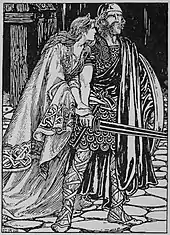Caroline Watts
Caroline Marsh Watts (1868–1919) was a British painter. She was born in Handsworth, now part of Birmingham, and died at Colehill in Dorset.[1]
Caroline Marsh Watts | |
|---|---|
 Poster by Caroline Marsh Watts (in 1908) | |
| Born | 1868 Handsworth, England |
| Died | 1919 Colehill, England |
| Nationality | British |
| Occupation | Painter |
| Parent |
|
Life


Caroline Watts was the youngest child of Robert Watts. He manufactured buttons in Handsworth up to the year 1891, when he retired and moved to St Margarets in the Twickenham area with his youngest children. Caroline Watts studied at the Slade School of Fine Art in London.[1] Upon their father's death in 1894, Watts and her sister Mary moved to Pimlico. In the 1901 census, the sisters stated Mary's occupation was compiler of indexes, while Caroline worked as a painter.[1]
The first illustrations that can be traced back to her were drawn from 1899 on. Some depict the King Arthur legend, while others were drawn for various historical novels written by Jessie Weston and published by Alfred Nutt. Upon Nutt's death, his wife M. L. Nutt, an involved women's rights activist, took over the publishing house.[2] Under her watch, various suffragette works were published. It is therefore assumed that she put Watts in touch with the women's right activists.
In 1908, Watts created the Artists' Suffrage League's promotional poster Bugler Girl for the National Union of Women's Suffrage Societies' June demonstrations.[3] The motif was thereafter made the logo of the suffragette newspaper and was copied frequently. It was also borrowed by the Women's suffrage in the United States movement and recoloured in purple, white and green.[4][5]
Watts and her sister lived in Godalming in 1911 and had moved to Colehill, Dorset by 1918.
Selection of book illustrations
- Gottfried von Straßburg: The Story of Tristan and Iseult. Translated from the German by Jessie L. Weston. Illustrations by Caroline Watts. 1899
- Guingamor, Launfal, Tyolet, The were-wolf. Translated from the French by Jessie Laidley Weston. Illustrations by Caroline Watts. Nutt, London. 1900
- Marie de France: Seven of her Lays. Translated from the French by Edith Rickert. Illustrations by Caroline Watts. Nutt, London. 1901
- Arthur Herbert Leahy (Publisher): The Courtship of Ferb : an old Irish romance ; transcribed in the twelfth century into the Book of Leinster. Illustrations by Caroline Watts. Nutt, London. 1902
- Sir Cleges ; Sir Libeaus Desconus: two old English metrical romances. Prose by Jessie L. Weston. Illustrations by Caroline Watts. Nutt, London. 1902
- Samuel Taylor Coleridge: Christabel. Illustrations by Caroline Watts. J.M. Dent, London. 1904
- Sir Gawain at the Grail Castle. Translated from the French by Jessie L. Weston. Illustrations by Caroline Watts. 1904
- Katharine Tynan: The wild harp: a selection from Irish poetry. Illustrations by Caroline Watts. London. 1913
References
- Crawford, Elizabeth (3 December 2014). "Suffrage Stories/Women Artists: Caroline Watts And the 'Bugler Girl'". Retrieved 6 January 2019.
- H. R. Tedder, rev. Sayoni Basu (2004). "Nutt, Alfred (1856–1910)". Oxford Dictionary of National Biography (online ed.). Oxford University Press. doi:10.1093/ref:odnb/35269. Retrieved 16 January 2019. (Subscription or UK public library membership required.)
- Tickner, Lisa (1987). The spectacle of women : imagery of the Suffrage Campaign 1907–14. London: Chatto & Windus. p. 250. ISBN 0-7011-2952-2.
- Tickner (1987), p. 266
- Lucinda Gosling, Hilary Robinson & Amy Tobin (2019). Helena Reckitt (ed.). The Art of Feminism. Tate Publishing.
External links
- Caroline Watts on Artblogs
- Finley, Gaelle (30 April 2018). "Caroline Marsh Watts". Retrieved 6 January 2019.